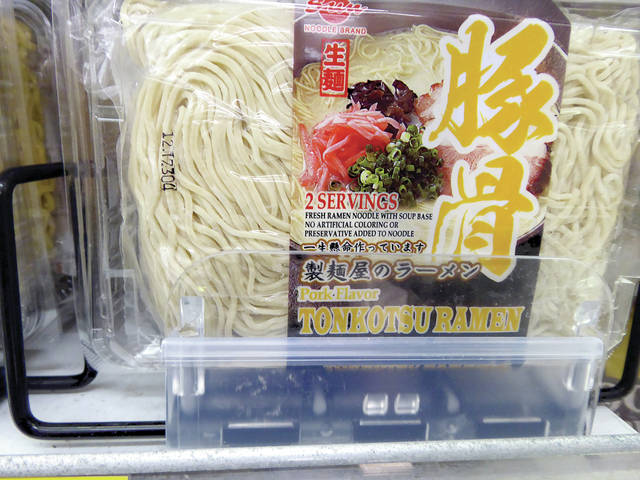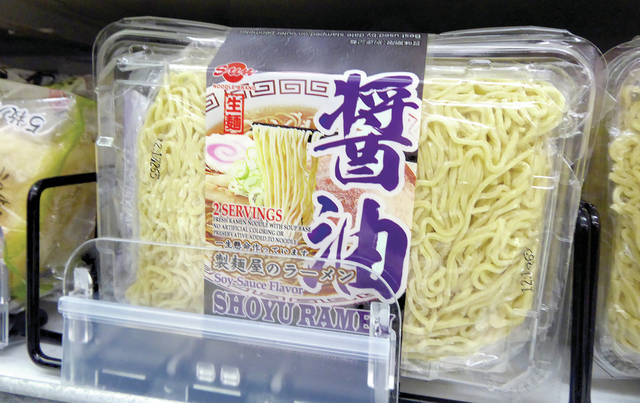Let’s Talk Food: Ramen gaining popularity

Courtesy of AUDREY WILSON Sun Noodles tonkotsu ramen.

Courtesy of AUDREY WILSON Sun Noodles shoyu ramen.
The special issue of Bon Appetit about the foods we crave says this about ramen: “We’ve reached peak ramen, with noodle shops and neo-izakayas in seemingly every American city.”
The special issue of Bon Appetit about the foods we crave says this about ramen: “We’ve reached peak ramen, with noodle shops and neo-izakayas in seemingly every American city.”
Some of the featured bowls are shio (salt) ramen from Noraneko in Portland, Ore. — “Order extra garlic and press the cloves into this shio ramen topped with pork belly chasyu” — or the spicy tantanmen from Ramen Shop in Oakland, Calif. — “Leave it to a couple of Chez Panisse alums to serve ramen with leeks and bok choy from local farms” — or Hell Paitan from Ken’s Ramen or Providence, R.I., — with “the base for this bowl with kikurage mushrooms, nori and chili oil is simmered for 30 hours” — or spicy ramen from Osaka Ramen in Denver — “Chef Jeff Osaka tried more than 50 versions of Sun noodles before he landed on a custom version with the perfect chew.”
ADVERTISING
Sun noodles? That is a Hawaii-based company that makes specialty noodles for chefs. Their main ramen-eating zones include New York City, California and Hawaii. Sun Noodle supplies David Chang’s Momofuku restaurants Ivan Ramen and Ippudo and is available at Whole Foods and most grocery stores carrying Oriental products.
According to Wilfred Hisashi of Ken’s Ramen in Province, “In terms of quality and freshness, they’re unbeatable.”
Sun Noodle considers itself as chef-driven for the past 35 years. During that time, the company created more than 300 different types of noodles to complement different broths and toppings.
Hidehito Uki, at 19 years old, wanted to come to Hawaii to learn to speak English. He founded Sun Noodle in 1981, when there were only three or four ramen shops on Oahu. At home, everyone ate Cup of Noodles in the microwave. But Uki came from Japan and wanted to make and sell fresh ramen noodles. Today, Sun Noodle sells its noodles from Los Angeles to New York to Washington, D.C., Chicago and even Milwaukee. With its three factories (in Honolulu; California, which opened in 2004; and New Jersey, which son Kenshiro opened in 2011) producing noodles, the company now makes 90,000 servings of ramen noodles a day.
Nine out of 10 best ramen shops in the U.S. buy from Sun Noodle.
In 2012, Kenshiro launched Ramen Lab out of the New Jersey factory “as an innovative educational concept that brought together chefs and consumer from around the world who shared the passion for ramen.”
The essentials to make Sun noodles include:
Kansui: This is an essential salt that gives ramen noodles their texture, color and flavor. A mixture of sodium carbonate and potassium carbonate are added with water and mixed into the dough.
Alkalinity: This is the opposite of acidity, and an essential characteristic of ramen noodles. This is what creates the firmer springy texture and the yellow hue. According to Harold McGee: “Something happens when you cook alkaline noodles that creates a flavor that’s unique and pleasant. We know the taste of acidity — its sourness, its tartness. Alkalinity is harder to register, but it’s a kind of slick feeling in your mouth.”
Some of the different broths include:
Dashi: Soup stock made from dashi-kombu (seaweed) and katsuo-boshi (dried bonito).
Chintan: Clear broth that was the original form of ramen broth.
Paitan: Milkier, turbid broth.
Tonkotsu: Pork bone broth that is fatty and creamy, common in the Kyushu area of Japan, which includes Hakata-style ramen and Kurume-style ramen.
Here is a basic ramen recipe from the Sun Noodle website, sunnoodle.com:
Basic Shoyu Ramen
Submitted by David Chan to Sun Noodle website
Serves: 8
Dashi stock:
2 quarts water
4 (3-inch) square pieces of dashi kombu (seaweed for making dashi)
1 ounce katsuboshi (shaved bonito flakes)
Shoyu tare:
1 1/2 cups shoyu
3/4 cup mirin
3/4 cup sake
1 tablespoon brown sugar
8 cloves garlic
1 pieces ginger, two inches long, sliced
2 pounds of pork belly or pork shoulder
Garlic oil:
1/2 cup of a neutral oil like canola or grapeseed oil
4 cloves garlic, sliced
Toppings:
Eggs
Green onions, thinly sliced
Seaweed (thinly sliced aji-nori)
Place kombu and water into a pot and set to high heat. Bring water to 175 degrees, reduce to lowest setting. If water is too hot, the kombu will give the broth a slimy texture. Turn heat off, let kombu sit in water for 1 hour.
Remove kombu and add katsuoboshi, making sure your water is still at 175 degrees. Turn off heat, let katsuoboshi steep for 10 minutes. Strain.
Preheat oven to 200 degrees. In an oven proof pot, over high heat, sear pork with a dollop of oil on all sides to give it a nice browning. This will start the Maillard reaction and help develop flavors.
While your meat is searing, add all of your liquid ingredients together with the sugar. Once you have seared your meat, add this mixture to your pot with garlic and green onions. Bring the liquid almost up to a boil then place your pot in the oven for 2 1/2 to 3 hours or until meat is tender. Strain the marinade to use as your tare.
Garlic oil:
Thinly slice your garlic and place into a small pot with 1/2 cup oil. Set the heat to low and slowly fry the garlic. Keep an eye on the garlic as it can easily burn. When the garlic turns golden brown, remove from heat and set aside.
Toppings:
In addition to the chashu you made, you can add eggs, green onions, seaweed, bamboo shoots and kamaboko.
To make soft-boiled eggs:
Place eggs into boiling water, cook for 6 1/2 minutes. Place in cold water and peel. The yolk should still be soft.
I just returned from Japan yesterday, where ramen is an institution. At 35-40 degree weather, a bowl of noodles hits the spot and warms the innards.
Foodie bites
The Hawaii Community College Food Service Department’s Cafeteria is open for business today till Friday. The cafeteria is open at 10:30 a.m. Call 934-2559 to place takeout orders or check if they have poke or chirashi bowls.
Email Audrey Wilson at audreywilson808@gmail.com.


